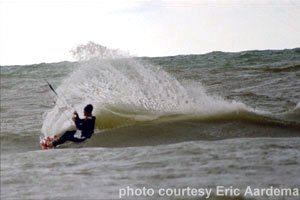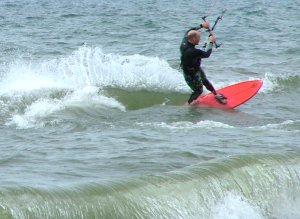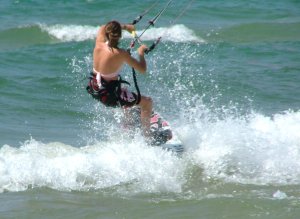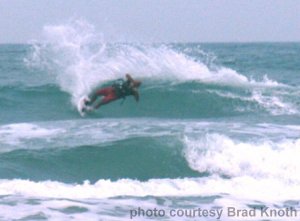Lake MI Wave Riding
Kiteboarding Tips
Tip #7 - Riding waves in Lake MI
by Eric Aardema
 If you have ever kited a windy day on Lake MI, you can't help but notice the waves as they stack up to the horizon. Depending on the wind direction, these waves can be downright ugly, closed-out and menacing as they try to knock you down and rip your board off your feet. Riding on a big day in Lake MI is a completely different experience compared to a nice buttery/bumpy day you may be used to riding in. The waves can be relentless as they just keep rolling in. The sets are very close together and each wave can vary in shape, size and strength. Every element is accelerated, exaggerated and moving faster than you are normally used to. There are many forces working around you, so you need to be on your game. It can be scary at first, but once you get comfortable, you can score some outstanding sessions. Riding waves can become highly addicting. Pursue at your own risk.
If you have ever kited a windy day on Lake MI, you can't help but notice the waves as they stack up to the horizon. Depending on the wind direction, these waves can be downright ugly, closed-out and menacing as they try to knock you down and rip your board off your feet. Riding on a big day in Lake MI is a completely different experience compared to a nice buttery/bumpy day you may be used to riding in. The waves can be relentless as they just keep rolling in. The sets are very close together and each wave can vary in shape, size and strength. Every element is accelerated, exaggerated and moving faster than you are normally used to. There are many forces working around you, so you need to be on your game. It can be scary at first, but once you get comfortable, you can score some outstanding sessions. Riding waves can become highly addicting. Pursue at your own risk.
 This article will cover riding the waves using the power of the kite. Also, note that I am referring to a frontside style of riding the wave; frontside is riding facing the wave. I use my favorite twin-tip and a Boxer SLE - sizes depend on wind conditions.
This article will cover riding the waves using the power of the kite. Also, note that I am referring to a frontside style of riding the wave; frontside is riding facing the wave. I use my favorite twin-tip and a Boxer SLE - sizes depend on wind conditions.
In order to feel confident riding in the waves, and for the safety of others, you should have the following skills dialed in:
- Need to be able to ride upwind
- Body drag and recover lost board (in the event that your board is ripped off your feet)
- Ride well both toe-side and regular stance.
- Relauch quickly (sometimes you've got to hustle so you don't get worked)
- Jumping - jump over large sets of whitewater when the waves get big.
Stay away from surfers, swimmers and others playing in the water at all times.
The new Bow or SLE kites work great in the waves, as they relaunch quickly, turn quickly and have good depower so you can slow it down a bit.
What are the right conditions?
Steady, sideshore winds with a nice large pier or jetty to hide behind. This setup is ideal as you can ride near the pier where the waves are smaller to get outside.
"S" Turns - Learning to carve
Good practice before you go out in the waves is to try to do powered "S" turns riding downwind. Throw the kite downwind into a toe-side turn and follow it through, before you get halfway into the turn, crank the kite back into a heelside turn. Make big arcs with the kite and link up your turns so they are smooth with good board speed. It should feel like the kite is pulling you though the turn. This is the first step to riding waves.
Start out small and close to shore
 The next step is to go out on a day with a good sideshore breeze and nice little waves. 1 to 2 footers are the best to start with. Begin playing in the break on the first sand bar and try your "S" turns downwind. Make attempts to run at the face of the wave and do a hard heelside turn onto it. At first it doesn't matter if you stay on the wave or not; just get the feeling of riding towards it, carving, and riding away. Repeat as many times as necessary to get the feeling of turning down the line. Try to have the kite one step ahead of your board; you always want the kite in front of you pulling you down the line and ready for rider input... you can always sheet out to slow down to get on or stay on waves.
The next step is to go out on a day with a good sideshore breeze and nice little waves. 1 to 2 footers are the best to start with. Begin playing in the break on the first sand bar and try your "S" turns downwind. Make attempts to run at the face of the wave and do a hard heelside turn onto it. At first it doesn't matter if you stay on the wave or not; just get the feeling of riding towards it, carving, and riding away. Repeat as many times as necessary to get the feeling of turning down the line. Try to have the kite one step ahead of your board; you always want the kite in front of you pulling you down the line and ready for rider input... you can always sheet out to slow down to get on or stay on waves.
Getting out through the shore break
 The next step is to go out on a bigger day. Sideshore wind with nice 3 to 4 foot waves is a great way to start going down the line. As soon as the waves get to 3 to 4 feet, you will need to perfect another valuable skill: punching out through the breaking waves.
The next step is to go out on a bigger day. Sideshore wind with nice 3 to 4 foot waves is a great way to start going down the line. As soon as the waves get to 3 to 4 feet, you will need to perfect another valuable skill: punching out through the breaking waves.
Time to catch one
 Once you are through the break and on the outside, spot a small wave. You will need to turn around and get in front of the wave and slowly work your way upwind as the wave is shaping up. The waves will get larger, longer and more powerful further downwind of the pier. As they reach the sandbars they shape up and break. Try to stay upwind on the wave. Riding slow is the key. You have to watch and wait, wait, wait as the wave face builds vertically. Timing is key. Once you see the wave shape up to your desire, you must turn the kite downwind (toe-side turn) into the wave as it begins to pitch... in a smooth motion ride up the face while redirecting the kite, and near the top of the wave, do a hard heel-side turn to crack the lip; you will then be set up and ready to initiate another bottom turn. Repeat this process as many times as you can before the wave reaches shore or your legs poop out.
Once you are through the break and on the outside, spot a small wave. You will need to turn around and get in front of the wave and slowly work your way upwind as the wave is shaping up. The waves will get larger, longer and more powerful further downwind of the pier. As they reach the sandbars they shape up and break. Try to stay upwind on the wave. Riding slow is the key. You have to watch and wait, wait, wait as the wave face builds vertically. Timing is key. Once you see the wave shape up to your desire, you must turn the kite downwind (toe-side turn) into the wave as it begins to pitch... in a smooth motion ride up the face while redirecting the kite, and near the top of the wave, do a hard heel-side turn to crack the lip; you will then be set up and ready to initiate another bottom turn. Repeat this process as many times as you can before the wave reaches shore or your legs poop out.
Getting the kite timed with your bottom and top turns is the key... it's all about timing and feel, which you will develop as you progress. If you are getting pulled out the back of the wave, you are redirecting the kite too late. Try to have the kite one step ahead of your board. Twin tips are really fun for this style of wave riding. I also recently purchased a Naish 5'2" Kitewave that I am itching to try out this season. I can't wait until I get that dialed in.
